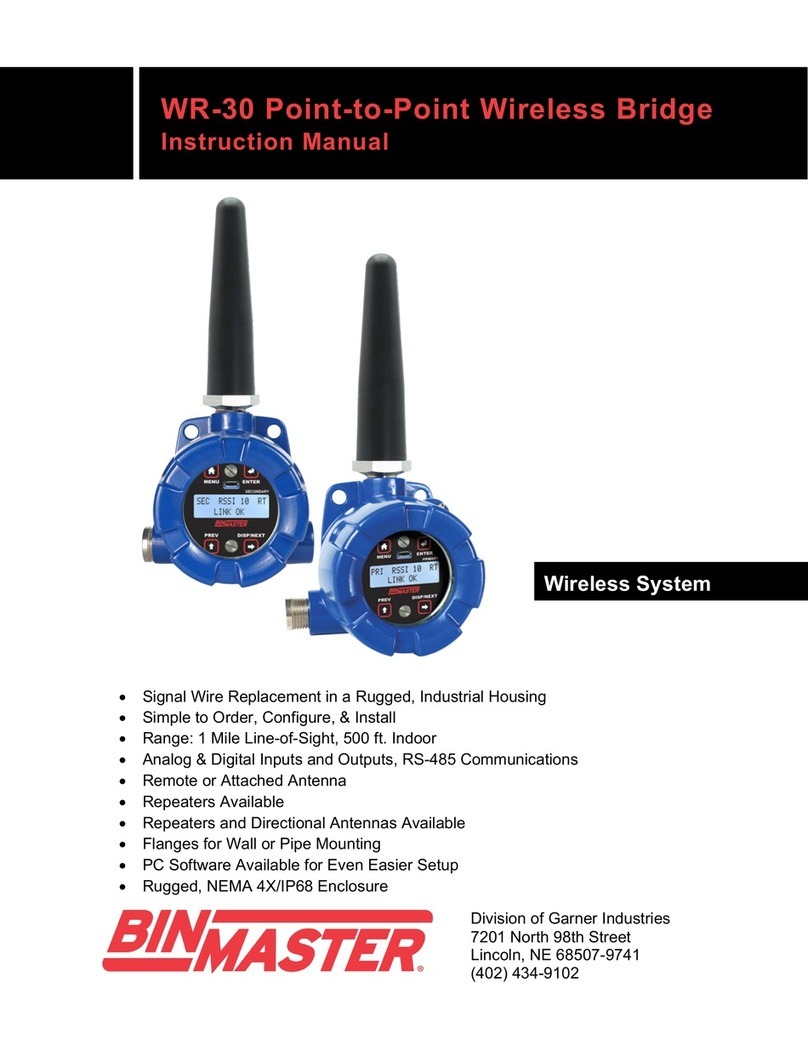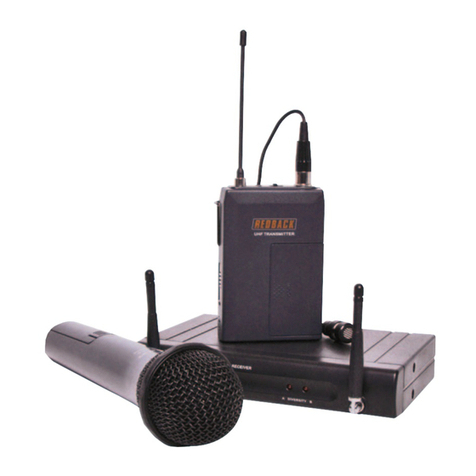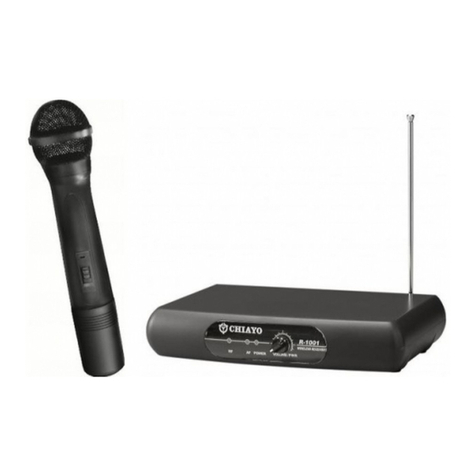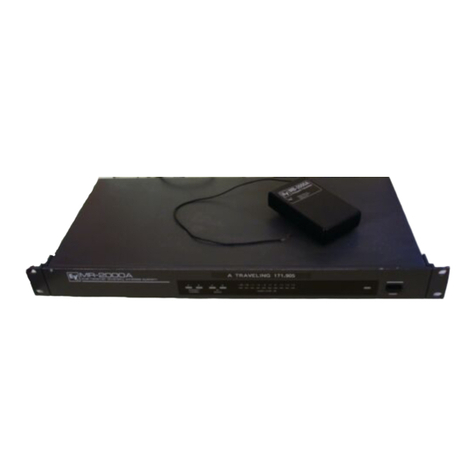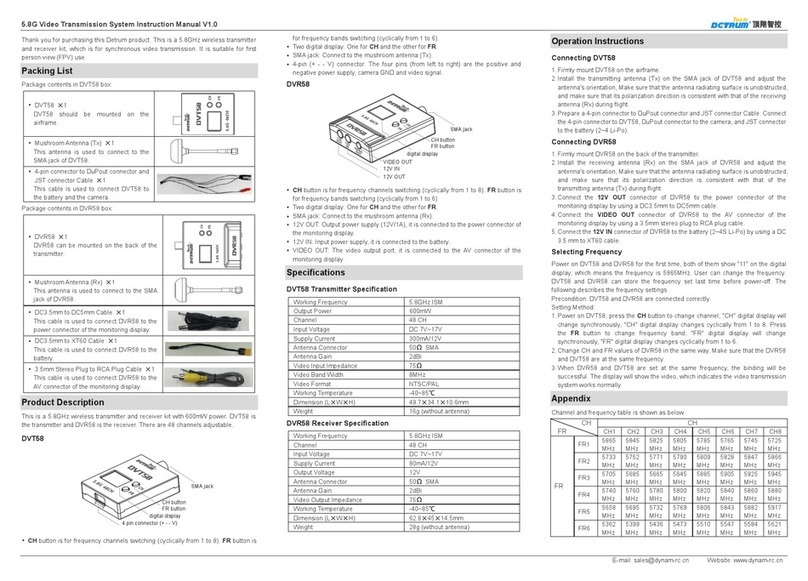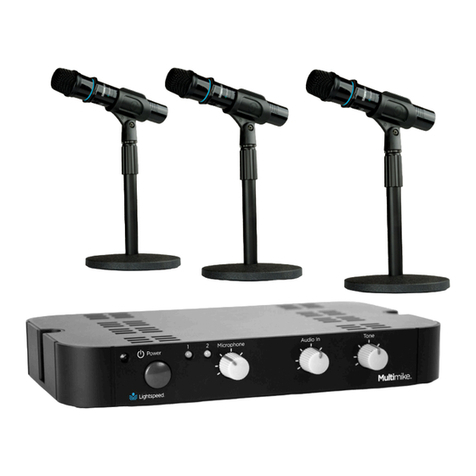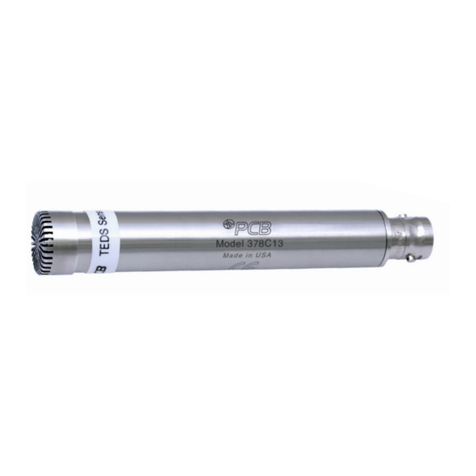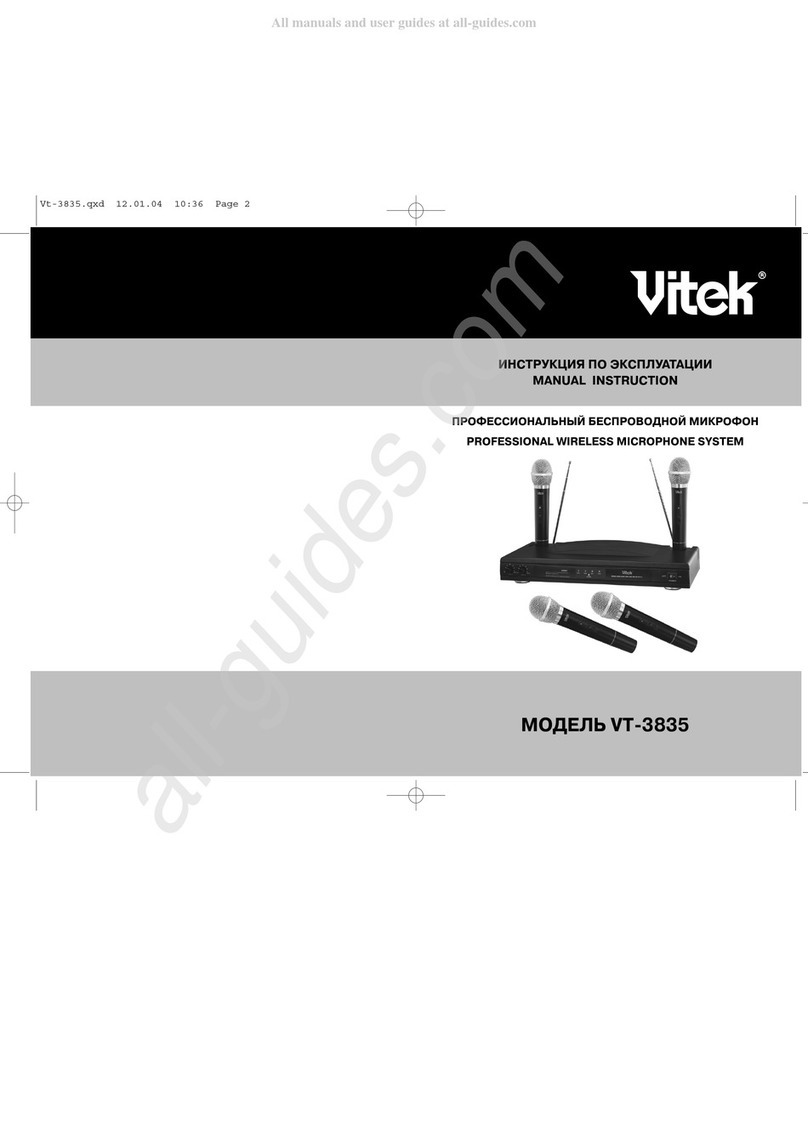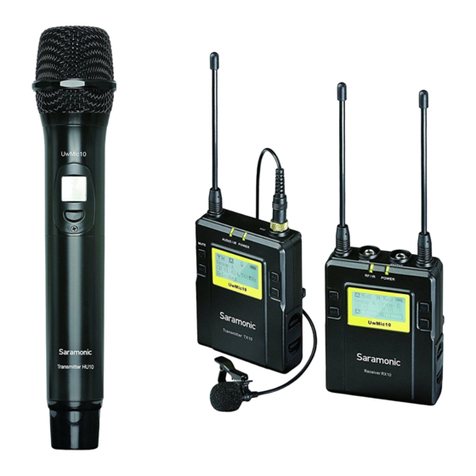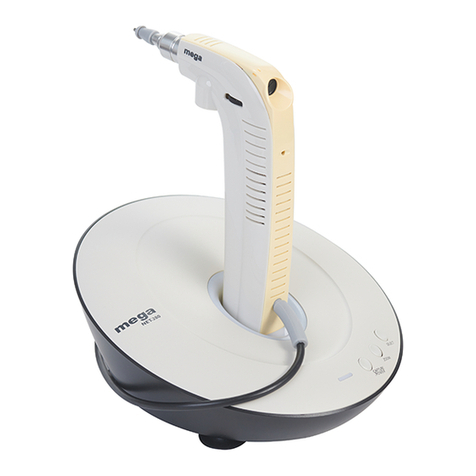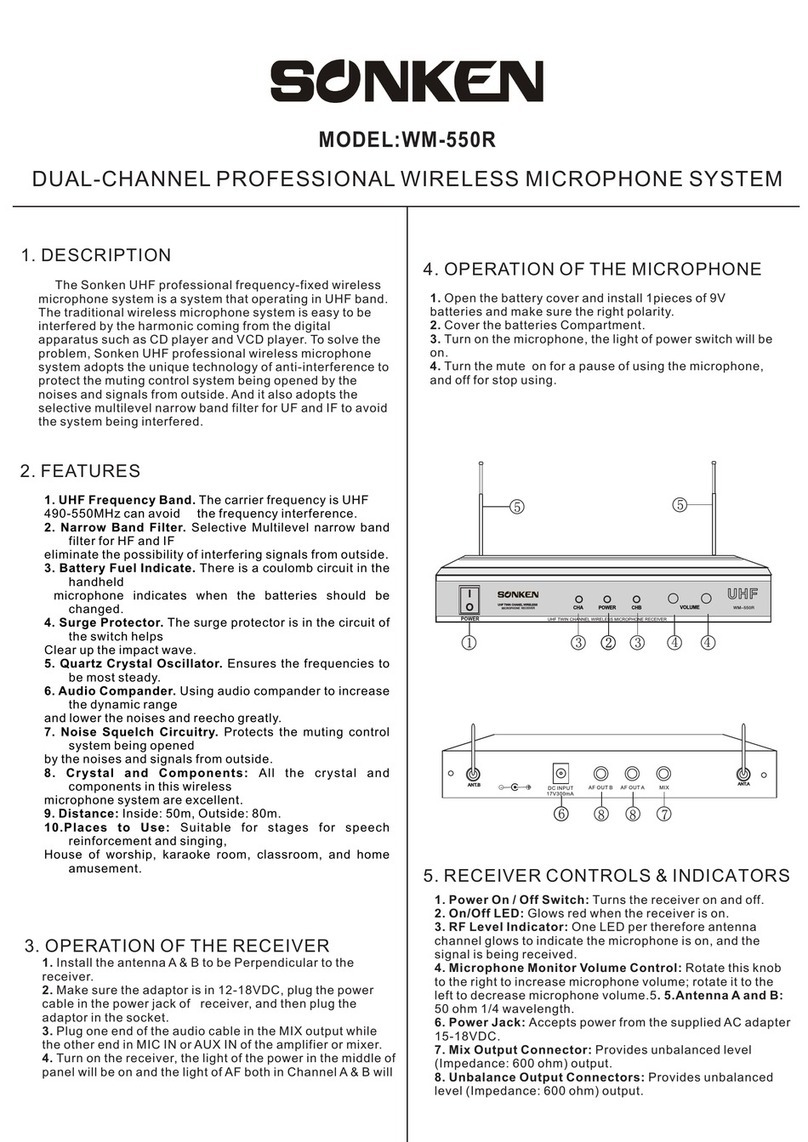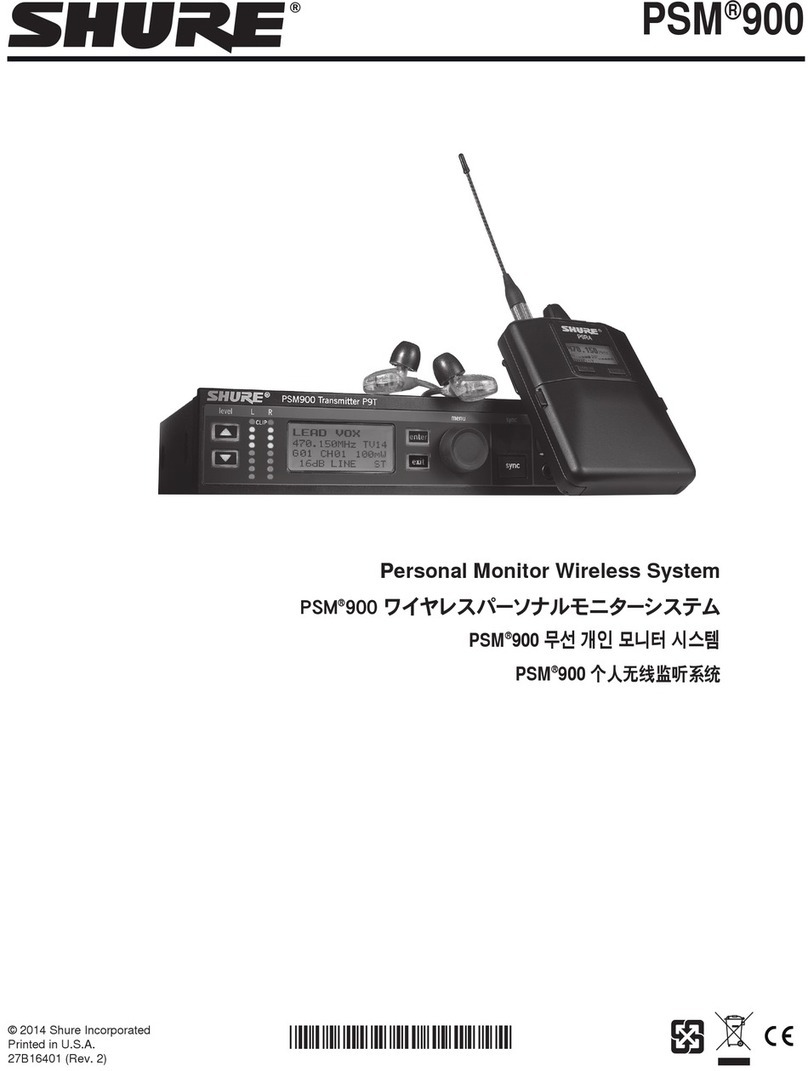Bin Master WR-90 Series User manual

WR-90 Point to Multi-Point Wireless
Instruction Manual
Division of Garner Industries
7201 North 98th Street
Lincoln, NE 68507-9741
(402) 434-9102
Wireless System
• Point to Multi-Point Signal Wire Replacement
• Simple to Configure Using WR Manager
Programming Software and Onboard USB
• Range: 1 Mile Line-of-Sight, 500 Ft Indoor
• Analog, Digital, and RS-485 Inputs and Outputs
• Remote or Attached, Directional and Omnidirectional Antennas Available
• Field Units Feature Flanges for Wall or Pipe Mounting
• Base Station Housed in Plastic NEMA 4X Field Enclosure
• Field Units Housed in IP68, NEMA 4X Enclosure

WR-90 Point to Multi-Point Wireless Instruction Manual
2
Disclaimer
The information contained in this document is subject to change without notice. BinMaster
makes no representations or warranties with respect to the contents hereof and specifically
disclaims any implied warranties of merchantability or fitness for a particular purpose.
Caution: Read complete
instructions prior to installation and
operation of the device.
Warning: Risk of electric shock or
personal injury.
Warning!
This product is not recommended for life support
applications or applications where malfunctioning could
result in personal injury or property loss. Anyone using
this product for such applications does so at their own
risk. BinMaster shall not be held liable for damages
resulting from such improper use.
Limited Warranty
BinMaster warrants this product against defects in material or workmanship for the specified
period under “Specifications” from the date of shipment from the factory. BinMaster’s liability
under this limited warranty shall not exceed the purchase value, repair, or replacement of
the defective unit.
Registered Trademarks
Modbus® is a registered trademark of Schneider Electric. All other trademarks mentioned in
this document are the property of their respective owners.
© 2019 BinMaster. All rights reserved.
www.binmaster.com
!

WR-90 Point to Multi-Point Wireless Instruction Manual
3
Table of Contents
Table of Contents ................................................... 3!
Table of Figures ..................................................... 3!
Introduction ............................................................. 4!
Ordering Information .............................................. 5!
Specifications ......................................................... 6!
WR-90 Base Station Specifications .................... 6!
General ........................................................... 6!
Dual Analog Inputs Module ............................. 6!
Dual 4-20 mA Outputs Module ........................ 6!
Digital Input / Output Module ........................... 6!
Dual Relays Module ........................................ 6!
WR-90 Field Unit Specifications ......................... 7!
General ........................................................... 7!
Isolated 4-20 mA Transmitter Output .............. 7!
Digital Input / Output Terminal ........................ 7!
General Specifications ........................................ 8!
Wireless Radio ................................................ 8!
WR Manager Software .................................... 8!
RS-485 Modbus® RTU Serial Comms ............. 8!
Safety Information .................................................. 8!
Installation .............................................................. 8!
Unpacking ........................................................... 8!
Pre-Installed Conduit Plug .................................. 9!
Base Station Conduit Holes ................................ 9!
Mounting Instructions .......................................... 9!
Cover Jam Screw................................................ 9!
FCC Notice ......................................................... 9!
IMPORTANT ................................................... 9!
Canada (IC) Notice ......................................... 9!
Base Station Connections ................................ 10!
Power Connector .......................................... 11!
Analog Input Connector ................................ 11!
Analog Output Connector .............................. 11!
Digital I/O Connector ..................................... 11!
Relays Connector .......................................... 12!
Switching Inductive Loads ............................. 12!
Modbus RTU Serial Communications ........... 13!
Field Unit Connections ...................................... 14!
Power Connector .......................................... 15!
Signal Connector ........................................... 16!
4-20 mA Output Connector ........................... 16!
Digital I/O Connector ..................................... 16!
Modbus RTU Serial Communications ........... 17!
Setup and Programming ...................................... 18!
Overview ........................................................... 18!
Programming the Base Station ......................... 18!
Connecting Field Units to Base Station ......... 19!
Base Station Configuration ........................... 20!
Input / Output Module Configuration ............. 21!
Remote Unit Configuration ............................ 25!
Advanced Configuration ................................ 29!
Programming the Field Units ............................ 30!
Field Unit Setup Menu ................................... 31!
Programming the Field Units with WR Manager
...................................................................... 34!
Troubleshooting .................................................... 37!
Mounting Dimensions ........................................... 40!
PDA6963-BM Stainless Steel Pipe Mounting Kit for
Field Units ............................................................ 41!
Table of Figures
Figure 1. Fully Loaded Base Station Main Board . 10!
Figure 2. Base Station Power Connection ........... 11!
Figure 3. Base Station Analog Input Connection 11!
Figure 4. Base Station Digital I/O Connection ...... 11!
Figure 5. Base Station Analog Output Connection
.............................................................................. 11!
Figure 6. Base Station Relays Connection ........... 12!
Figure 7. AC and DC Loads Protection ................ 12!
Figure 8. Low Voltage DC Loads Protection ........ 12!
Figure 9. Base Station Three- and Five-Wire RS-
485 Modbus Connection ...................................... 13!
Figure 10. Base Station Multiple Device RS-485
Modbus Connection ............................................. 13!
Figure 11. Field Unit Device Assembly, Rear View
.............................................................................. 14!
Figure 12. Field Unit Power Connection .............. 15!
Figure 13. WR-90 Field Unit and 2-Wire Transmitter
Powered from Same Supply ................................. 15!
Figure 14. Field Unit Analog Input Connection ..... 16!
Figure 15. Field Unit 4-20 mA Output Connection
.............................................................................. 16!
Figure 16. Field Unit Digital I/O Connection ......... 16!
Figure 17. Field Unit Three- and Five-Wire RS-485
Modbus Connection ............................................. 17!
Figure 18. Field Unit Multiple Device RS-485
Modbus Connection ............................................. 17!
Figure 19. Base Station Dimensions – Front View
.............................................................................. 40!
Figure 20. Base Station Dimensions – Side View 40!
Figure 21. Field Unit Dimensions – Front View .... 40!
Figure 22. Field Unit Dimensions – Side Cross
Section View ......................................................... 40!
Figure 23. PDA6963-BM Stainless Steel Pipe
Mounting Kit for Field Units .................................. 41!

WR-90 Point to Multi-Point Wireless Instruction Manual
4
Introduction
The BinMaster WR-90 is a rugged, customizable, point-to-multipoint wireless bridge. It offers a
highly-flexible means of getting analog, digital, and Modbus® signals from where you have them
to where you need them. Modular input/output cards and expandable field units mean that the
WR-90 can be customized to meet the needs of any wireless application.
The WR-90 is simple to order, simple to configure, and easy to trust with your application. It can
be ordered as either preassembled kits or as individual, modular components. Guaranteed
ranges assure it will work with your application or you can send it back - no questions asked. A
wireless survey tool is available for those installations that require a site survey for longer
distances, making it easy to verify the setup will work the first time.
Field units accept analog, discrete, and Modbus® inputs and wirelessly broadcast them to the
WR-90 base station. The base station can recreate these signals with its onboard RS-485 or
analog and digital I/O cards. It can also be programmed to activate relays or output
analog/digital signals to the field units. Just put the field units wherever there are process
signals and the base station in the control room.
Fixed or remote antenna modules as well as a wide range of accessories are available,
including mounting kits, antenna-related accessories, and repeaters. The antenna may be
directly attached or remotely located. High gain directional antennas are also offered.

WR-90 Point to Multi-Point Wireless Instruction Manual
5
Ordering Information
WR-90 Wireless Components
Model Number
Description
WR-90-BA
WR-90 Point-to-Multipoint Wireless Process Signal Base Station
WR-90-TR
WR-90 Point-to-Multipoint Wireless Process Signal Field Unit
Base Station Modules
Model Number
Description
WR-90-CA
WR-90 Dual Analog Input Base Station Module
WR-90-CT
WR-90 Dual Analog Output Base Station Module
WR-90-CR
WR-90 Dual Relay Output Base Station Module
WR-90-CD
WR-90 Dual Digital I/O Base Station Module
Accessories
Model Number
Description
WR-30-RP
Wireless Repeater Kit
PDA3120-S-BM
RP-SMA M/F Antenna Cable 20ft
PDA3140-S-BM
RP-SMA M/F Antenna Cable 40ft
PDA3120-N-BM
RP-SMA F to N Male Antenna Cable 20ft
PDA3140-N-BM
RP-SMA F to N Male Antenna Cable 40ft
PDA3900-12-N-BM
PDW 900 MHz Antenna, 1/2" NPT
PDA3900-6Y-N-BM
Yagi Antenna 6dB
PDA3900-9Y-N-BM
Yagi Antenna 9dB
PDA6963-BM
Stainless Steel Field Unit Mounting Kit

WR-90 Point to Multi-Point Wireless Instruction Manual
6
Specifications
Except where noted all specifications apply to operation at +25°C.
WR-90 Base Station Specifications
General
Maximum
Connected
Field Units
32 field units
Network ID
Programmable: 0 - 99
Programming
Methods
Via PC with WR Manager software
Power
24 VDC ±10%, 36 W max, 2.4 W
min; Power consumption is
dependent on type and number of
modules installed
Non-Volatile
Memory
All programmed settings are stored
in non-volatile memory for a
minimum of ten years if power is
lost.
Environmental
Operating temp. range: -40 to 65°C
Storage temp. range: -40 to 85°C
Relative humidity: 0 to 90% non-
condensing
Connections
Removable screw terminal blocks
accept 12 to 22 AWG wire.
Peak Antenna
Gain
2.15 dBi ± 1.0
Enclosure
15.75" x 11.81" x 7.03" (40 cm x 30
cm x 17.9 cm) (W x H x D);
NEMA 4X; Thermoplastic Polyester;
Color: Gray
Tightening
Torque
Screw terminal connectors: 5 lb-in
(0.56 Nm)
Shipping
Dimensions
17" x 14" x 9" (43.2 cm x 35.6 cm x
22.9 cm) (W x H X D)
Shipping
Weight
6.5 lbs (2.95 kg)
Warranty
3 years parts & labor
Dual Analog Inputs Module
Inputs
Field selectable: 4-20 mA, 0-10 V,
0-5 V, 1-5 V
Accuracy
±0.03% of calibrated span ±1 count
Isolation
500 V
Recalibration
All ranges are calibrated at the
factory. Recalibration is
recommended at least every
12 months.
Temperature
Drift
0.005% of calibrated span/°C max
from 0 to 65°C ambient,
0.01% of calibrated span/°C max
from -40 to 0°C ambient
Signal Loss
Inputs will remain off (open circuit)
until wireless units are reconnected.
Input
Impedance
Voltage ranges: greater than
110 kW
Current ranges: less than 220 W
HART
Transparency
Analog input will not interfere with
existing HART communications on
the wired 4-20 mA signal
Dual 4-20 mA Outputs Module
Output Source
Analog input from connected
wireless unit
Calibration
Factory calibrated:
4.000 to 20.000 = 4-20 mA output
Accuracy
± 0.1% of span ± 0.004 mA
Isolation
500 V
Temperature
Drift
0.4 µA/°C max from 0 to 65°C
ambient, 0.8 µA/°C max from -40 to
0°C ambient.
Loop Power
Supply
Internally powered; no external
supply needed
Output Loop
Resistance
Power supply
Minimum
Maximum
24 VDC
10 W
900 W
Signal Loss
After approximately 25 seconds of
trying to reconnect, mA output will
become 3.2 mA
Digital Input / Output Module
Channels
Four (4) digital connections,
independently field selectable as
either inputs or outputs
DI Logic High
3 to 5 VDC
DI Logic Low
0 to 1.1 VDC
DI Contact
Dry contact to ground can be used
to activate the input
DO Logic High
3 to 5 VDC
DO Logic Low
0 to 0.4 VDC
Source
Current
10 mA maximum output current
Sink Current
1.5 mA minimum input current
Signal Loss
Digital output goes to logic high
Dual Relays Module
Rating
2 SPDT (Form C); rated 3 A @
30 VDC and 125/250 VAC resistive
load; 1/14 HP (≈ 50 W) @ 125/250
VAC for inductive loads
Noise
Suppression
Noise suppression is recommended
for each relay contact switching
inductive loads; see page 12 for
details.
Initialization
After power failure, relays will
initialize to default state before
reconnecting to wireless units.
Signal Loss
If mapped to digital input channel,
the relay energizes.

WR-90 Point to Multi-Point Wireless Instruction Manual
7
WR-90 Field Unit Specifications
General
Display
32-character dual-line alphanumeric
dot matrix LCD display with backlight
(4.68mm x 2.21mm characters)
Display
Orientation
Display may be mounted at 180°
from default orientation
Network ID
Field selectable: 0 - 99
Programming
Methods
Four programming buttons (behind
glass) or PC with WR Manager
software.
Recalibration
All inputs and outputs are calibrated
at the factory. Recalibration is
recommended at least every
12 months.
Process/
Digital I/O
Display
Press the display button once to
display the present analog input and
output. Press the display button
again to display digital I/O states.
Password
A programmable password restricts
modification of programmed settings.
Power
12-28 VDC, 5 W max
Non-Volatile
Memory
All programmed settings are stored
in non-volatile memory for a
minimum of ten years if power is lost.
Isolation
500 V
Environmental
Operating temp. range: -40 to 65°C
(display inoperable < -20 °C)
Storage temp. range: -40 to 85°C
Relative humidity: 0 to 90% non-
condensing
Connections
Removable screw terminal blocks
accept 16 to 30 AWG wire.
Enclosure
Cast aluminum with glass window,
0.3% max copper content, corrosion
resistant powder coating, color: blue.
IP68. Two ½" NPT threaded conduit
openings. One ½" NPT stainless
steel conduit plug with 10 mm hex
key fitting installed.
Mounting
May be mounted directly to conduit.
Two mounting holes for 1.5" pipe or
wall mounting. See Mounting
Dimensions on page 40 for mounting
space requirements.
Signal
Connector
Tightening
Torque
2.2 lb-in (0.25 Nm)
Shipping
Dimensions
17" x 14" x 9" (43.2 cm x 35.6 cm x
22.9 cm) (L x W X H)
Shipping
Weight
5 lbs. (2.27 kg)
Warranty
3 years parts & labor
Analog Input
Inputs
Field selectable: 4-20 mA, 0-10 V,
0-5 V, 1-5 V
Accuracy
±0.03% of calibrated span ±1 count
Temperature
Drift
0.005% of calibrated span/°C max
from 0 to 65°C ambient,
0.01% of calibrated span/°C max
from -40 to 0°C ambient
Input
Impedance
Voltage ranges: greater than
110 kW
Current ranges: less than 220 W
Signal Loss
Inputs will remain off (open circuit)
until wireless units are reconnected.
HART
Transparency
Analog input will not interfere with
existing HART communications on
the wired 4-20 mA signal
Isolated 4-20 mA Transmitter Output
Output Source
Analog input from connected
wireless unit
Calibration
Factory calibrated:
4.000 to 20.000 = 4-20 mA output
Accuracy
± 0.1% of span ± 0.004 mA
Loop Power
Supply
Internally powered; no external
supply needed
Temperature
Drift
0.4 µA/°C max from 0 to 65°C
ambient, 0.8 µA/°C max from -40 to
0°C ambient
Output Loop
Resistance
Power supply
Minimum
Maximum
24 VDC
10 W
900 W
Signal Loss
After approximately 25 seconds of
trying to reconnect, mA output will
become 3.2 mA
Digital Input / Output Terminal
Channels
Four (4) digital connections,
independently field selectable as
either inputs or outputs
DI Logic High
3 to 5 VDC
DI Logic Low
0 to 1.1 VDC
DI Contact
Dry contact to ground can be used
to activate the input
DO Logic High
3 to 5 VDC
DO Logic Low
0 to 0.4 VDC
Source
Current
10 mA maximum output current
Sink Current
1.5 mA minimum input current
Signal Loss
Digital output goes to logic high

WR-90 Point to Multi-Point Wireless Instruction Manual
8
General Specifications
Wireless Radio
Frequency
900 MHz
Range
500 ft (152.4 m) indoor, 1 mi
(1.61 km) outdoor (line-of-sight)
Encryption
AES 128-bit encryption available
using WR Manager software
Interference
Reduction
Frequency Hopping Spread
Spectrum (FHSS)
Power Output
24 dBm (250 mW)
Sensitivity
-101 dBm
WR Manager Software
System
Requirements
Microsoft® Windows® XP/Vista/7/8/10
Communicatio
ns
USB 2.0 (Standard USB A to Micro
USB B)
Configuration
Configure devices one at a time
RS-485 Modbus® RTU Serial Comms
Compatibility
EIA-485
Connectors
Removable screw terminal connector
Max Distance
3,937' (1,200 m) max
Baud Rate
1200 – 57,600 bps
Data
8 bit (1 start bit, 1 or 2 stop bits)
Parity
Even, Odd, or None with 2 stop bits
Modbus
Timeout
0.5, 1, 2, 3, 4, 5 seconds;
user selectable
Safety Information
Caution: Read complete instructions
prior to installation and operation of the
device.
Warning: Read all product labels
completely and follow all instructions
and requirements listed on the labels
for installation or service.
Warning!
Installation and service should be performed only by trained
service personnel. Service requiring replacement of internal
components must be performed at the factory.
Installation
Base Station: All wiring connectors are accessed by opening the enclosure. To access electrical
connectors, unclasp enclosure and open.
Field Units: All pushbuttons and wiring connectors are accessed by opening the enclosure. To
access electrical connectors, remove the 2 captive screws and remove the display assembly.
Unpacking
Remove both units from box. Inspect the packaging and contents for damage. Report damages, if
any, to the carrier. If any part is missing or the units malfunction, please contact your supplier or
the factory for assistance.
!

WR-90 Point to Multi-Point Wireless Instruction Manual
9
Pre-Installed Conduit Plug
The WR-90 field units are supplied with one pre-installed optional conduit plug for installations that do not
require the use of both conduit entries. The conduit plug includes an internal hexagonal socket recess for
removal.
Base Station Conduit Holes
No predrilled conduit holes are provided in the base station enclosure from the factory. Drilling of conduit
holes is left to the end user so that they may be placed wherever appropriate for the application. Be sure
to use suitable hardware (cable glands, plugs, etc.) in order to maintain NEMA 4X/IP66 rating on the
enclosure.
Mounting Instructions
The base station can be wall mounted using the included mounting hardware. Securely screw the four
brackets into the threaded holes provided at the rear of the enclosure with the bend facing toward the wall
in order to provide the necessary clearance. Then, secure exposed mounting holes to wall.
The field units have two mounting holes that may be used for a 1.5” pipe mounting or wall mounting.
Alternatively, the unit may be supported by the conduit using the conduit holes provided. The antenna is
threaded into one of the three conduit holes and may be moved as appropriate for the installation.
It can also be mounted by using the PDA6963-BM mounting bracket in order to orient the device antenna
away from the pipe. Refer to Mounting Dimensions on page 40 for details on space requirements.
Cover Jam Screw
The cover jam screw should be properly installed once the field units have been wired and tested in a
safe environment. The cover jam screw is intended to prevent the removal of the units’ cover while in
operation without the use of tools. Using a M2 hex wrench, turn the screw clockwise until the screw
contacts the unit. Turn the screw an additional 1/4 to 1/2 turn to secure the cover.
Caution: Excess torque may damage the threads and/or wrench.
FCC Notice!
Contains FCC ID: MCQ-XB900HP
The enclosed device complies with Part 15 of the FCC Rules. Operation is subject to the following two
conditions: (i.) this device may not cause harmful interference and (ii.) this device must accept any
interference received, including interference that may cause undesired operation.
IMPORTANT
The RF module has been certified for remote and base radio applications. If the module will be used for
portable applications, the device must undergo SAR testing. This equipment has been tested and found
to comply with the limits for a Class B digital device, pursuant to Part 15 of the FCC Rules. These limits
are designed to provide reasonable protection against harmful interference in a residential installation.
This equipment generates, uses and can radiate radio frequency energy and, if not installed and used in
accordance with the instructions, may cause harmful interference to radio communications. However,
there is no guarantee that interference will not occur in a particular installation.
If this equipment does cause harmful interference to radio or television reception, which can be
determined by turning the equipment off and on, the user is encouraged to try to correct the interference
by one or more of the following measures: Re-orient or relocate the receiving antenna, Increase the
separation between the equipment and receiver. Connect equipment and receiver to outlets on different
circuits, or consult the dealer or an experienced radio/TV technician for help.
Canada (IC) Notice
Contains Model: XB900HP, IC: 1846A-XB900HP
Integrator is responsible for its product to comply with IC ICES-003 & FCC Part 15, Sub. B - Unintentional
Radiators. ICES-003 is the same as FCC Part 15 Sub. B and Industry Canada accepts FCC test report or
CISPR 22 test report for compliance with ICES-003.

WR-90 Point to Multi-Point Wireless Instruction Manual
10
Base Station Connections
To access the connectors for the base station, open the enclosure door. Signal connections are made to
removable screw terminal connectors.
Warning!
• The WR-90 base station must be powered down completely
prior to installing or removing any modules. Failure to do so
could result in damage to the electronics.
• Static electricity can damage sensitive components.
• Observe safe handling precautions for static-sensitive
components.
• Use proper grounding procedures/codes.
Figure 1 below shows the locations of screw terminal blocks on a fully loaded WR-90 base station
electronics board. This diagram shows the board loaded with four relay modules, four digital I/O modules,
four analog input modules, and four analog output modules. Actual module locations may differ.
Figure 1. Fully Loaded Base Station Main Board
I+ GI+ G
1 2
mA OUTPUT
+5 1 2 3 4 GND
DIGITAL I/O
V+ mA G
1 2
ANALOG INPUT
V+ mA GNO NC C
1 2
RELAY
NO NC C
NO NC C
1 2
RELAY
NO NC CV+ mA G
1 2
ANALOG INPUT
V+ mA G +5 1 2 3 4 GND
DIGITAL I/O
I+ G I+ G
1 2
mA OUTPUT
NO NC C
1 2
RELAY
NO NC C
NO NC C
1 2
RELAY
NO NC C
V+ mA G
1 2
ANALOG INPUT
V+ mA G
V+ mA G
1 2
ANALOG INPUT
V+ mA G
I+ GI+ G
1 2
mA OUTPUT
+5 1 2 3 4 GND
DIGITAL I/O
+5 1 2 3 4 GND
DIGITAL I/O
I+ G I+ G
1 2
mA OUTPUT
MOD ADDR 016 RT
RSSI 10

WR-90 Point to Multi-Point Wireless Instruction Manual
11
Power Connector
Power connections are made to a two-terminal connector labeled
POWER in Figure 1.
Make sure that the power supply can provide 24 VDC to the
wireless base station.
Analog Input Connector
The analog input module can accept either 4-20 mA, 0-10 V, 0-5 V,
or 1-5 V. The appropriate input type must be independently
programmed for each input channel.
The analog input will not interfere with any existing HART signal on
a 4-20 mA current loop. However, the HART signal will not be
transmitted wirelessly.
Analog Output Connector
The mA output module can be programmed to output a 4-20mA
analog signal associated with a remote field unit’s analog input or
Modbus register.
The signal can be transmitted to any device scaled to read a 4-20
mA signal as shown at right. The analog output is internally powered;
no external power supply is required.
Digital I/O Connector
The digital input module includes four independently programmable
I/O channels. All digital connections are referenced to ground; digital
input connections have an internal pull-up resistor. Each connection
may be set as either an input or an output.
In the diagram to the right, D3 is a digital input and D4 is a digital
output.
Figure 2. Base Station
Power Connection
Figure 3. Base Station
Analog Input Connection
Figure 4. Base Station
Digital I/O Connection
Figure 5. Base Station
Analog Output Connection
V+ mA G
1 2
ANALOG INPUT
V+ mA G
Current Signal
Source
Voltage Signal
Source
I+ G I+ G
1 2
mA OUTPUT
4-20 mA
Input Device
+5 1 2 3 4 GND
DIGITAL I/O

WR-90 Point to Multi-Point Wireless Instruction Manual
12
Relays Connector
The relays module includes two mechanical relays. Relay connections
are made to the six-terminal connector shown to the right.
Each relay’s C terminal is common only to the normally open (NO) and
normally closed (NC) contacts of the corresponding relay.
If a field unit’s digital input channel is mapped to a relay module
channel on the base station, the effect may be opposite of what is
expected. An open connection at the digital input will result in the relay
going into an active state. This is because the digital input channels
are active low. This can be changed by swapping the NO and NC
connections to the relay channel.
Switching Inductive Loads
The use of suppressors (snubbers) is strongly recommended when switching inductive loads to prevent
disrupting the microprocessor’s operation. The suppressors also prolong the life of the relay contacts.
Suppression can be obtained with resistor-capacitor (RC) networks assembled by the user or purchased
as complete assemblies. Refer to the following circuits for RC network assembly and installation:
Figure 7. AC and DC Loads Protection
Choose R and C as follows:
R: 0.5 to 1 Ω for each volt across the contacts
C: 0.5 to 1 µF for each amp through closed contacts
Notes:
1. Use capacitors rated for 250 VAC.
2. RC networks may affect load release time of solenoid loads. Check to confirm proper operation.
3. Install the RC network at the device's relay screw terminals. An RC network may also be installed
across the load. Experiment for best results.
Figure 8. Low Voltage DC Loads Protection
RC Networks
RC networks should be applied to each relay contact switching an inductive load.
Note: Relays are de-rated to 1/14th HP (50 watts) with an inductive load.
C
R
C
R
C
NC
NO
C
NC
NO
Figure 6. Base Station
Relays Connection
NO NC C
1 2
RELAY
NO NC C
Use a diode with a reverse
breakdown voltage two to
three times the circuit voltage
and forward current at least as
large as the load current.

WR-90 Point to Multi-Point Wireless Instruction Manual
13
Modbus RTU Serial Communications
The WR-90 base station acts as a simple pass-through for Modbus communications. As such, multiple
Modbus enabled devices may transmit and receive wirelessly using the base station.
Figure 9. Base Station Three- and Five-Wire RS-485 Modbus Connection
Figure 10. Base Station Multiple Device RS-485 Modbus Connection
Notes:
1. Termination resistors are optional and values depend on the cable length and characteristic
impedance. Consult the cable manufacturer for recommendations.
2. Use shielded cable, twisted-pairs plus ground. Connect ground shield only at one location.
Shield
Twisted-Pair
Shield
Twisted-Pair
(WR-90 Base Station)
(WR-90 Base Station)
RR
RR
Shield
Twisted-Pair
(WR-90 Base Station)
RR

WR-90 Point to Multi-Point Wireless Instruction Manual
14
Field Unit Connections
To access the connectors, remove the enclosure cover and unscrew the two captive stainless steel
screws. Remove the electronics assembly from the enclosure. Signal connections are made to removable
terminal blocks on the back of the electronics assembly. Grounding connections are made to the two
ground screws provided on the base – one internal and one external.
• Static electricity can damage sensitive components.
• Observe safe handling precautions for static-sensitive
components.
• Use proper grounding procedures/codes.
Warning!
• Observe all safety regulations. Electrical wiring should be
performed in accordance with all agency requirements and
applicable national, state, and local codes to prevent damage
to the device and ensure personnel safety.
Figure 11 below shows the locations of screw terminal blocks on the rear of the wireless field unit
assembly.
Figure 11. Field Unit Device Assembly, Rear View
Wireless
Module

WR-90 Point to Multi-Point Wireless Instruction Manual
15
Power Connector
Power connections are made to a two-terminal connector
labeled POWER in Figure 11. The WR-90 is reverse
polarity protected; it will not be damaged if wired backward.
Make sure that the power supply can provide between 12
and 24 VDC to the wireless device.
Power WR-90 Field Unit and 2-Wire Transmitter from Same Power Supply
The WR-90 wireless units may be powered from the same power supply that powers the 2-wire (loop-
powered) transmitter, assuming that the supply provides enough voltage for both units. To power both
devices from the same supply, wire the devices to the supply as shown below.
Figure 13. WR-90 Field Unit and 2-Wire Transmitter Powered from Same Supply
Wireless
Module
24 VDC
Power Supply
4-20 mA
2-wire
Transmitter
Wireless
Module
Figure 12. Field Unit Power
Connection

WR-90 Point to Multi-Point Wireless Instruction Manual
16
Signal Connector
The analog input may be either 4-20 mA, 0-10 V, 0-5 V, or 1-5 V.
The appropriate input type must be programmed for each unit.
Once the appropriate input type has been programmed, wire the
analog signal source to the device as shown in the diagram at
right.
The analog input will not interfere with any existing HART signal
on a 4-20 mA current loop. However, the HART signal will not be
transmitted wirelessly.
4-20 mA Output Connector
The 4-20 mA output corresponds with the analog input signal on
the paired wireless device. The analog output signal is always
4-20 mA, regardless of the input type on the other wireless
module.
For instance, if the analog input type on the first device was
0-10 V and the input value was 5 V, the second device would
output 12 mA.
Connect the mA OUT terminals to a device scaled to read a
4-20 mA signal.
The analog output is internally powered; no external power
supply is required.
Digital I/O Connector
All digital connections are referenced to ground. The base
station I/O settings determine the I/O settings of the field units
(e.g. if D1 of the base station is an input then it can only be
mapped to a digital output of a field unit).
Note: Each connection may be set independently in the
device settings as either an input or an output. In the
diagram to the right, D4 & D3 are digital inputs and D2
is a digital output.
Figure 14. Field Unit Analog
Input Connection
Figure 15. Field Unit
4-20 mA Output Connection
Figure 16. Field Unit Digital I/O
Connection
Voltage or
Current Signal
Source
4-20 mA Input
Display, Chart
Recorder, Etc.

WR-90 Point to Multi-Point Wireless Instruction Manual
17
Modbus RTU Serial Communications
The WR-90 field units act as simple pass-throughs for Modbus communications. As such, multiple
Modbus enabled devices may be transmitted wirelessly using a wireless field unit.
Note: Modbus Master must be connected to Base Station.
Figure 17. Field Unit Three- and Five-Wire RS-485 Modbus Connection
Figure 18. Field Unit Multiple Device RS-485 Modbus Connection
Notes:
1. Termination resistors are optional and values depend on the cable length and characteristic
impedance. Consult the cable manufacturer for recommendations.
2. Use shielded cable, twisted-pairs plus ground. Connect ground shield only at one location.
Shield
Twisted-Pair
Shield
Twisted-Pair
(WR-90 Field Unit)
(WR-90 Field Unit)
RR
RR
Shield
Twisted-Pair
(WR-90 Field Unit)
RR

WR-90 Point to Multi-Point Wireless Instruction Manual
18
Setup and Programming
The base station and field units are factory calibrated
prior to shipment to read analog inputs in milliamps or
volts depending on the input selection. The calibration
equipment is certified to NIST standards.
Overview
There are no jumpers to set for wireless device input selection. Setup and programming of the base
station is done using WR Manager programming software. Setup of the wireless field units is done either
wirelessly through the base station using WR Manager programming software or via direct USB
programming with WR Manager. The field units’ programming buttons located underneath the enclosure
cover are for very limited programming options, such as network ID and Modbus address.
Programming the Base Station
The base station is programmed using WR Manager programming software. WR Manager can be found
on the included CD.
Once the software is running, power the unit using a 24 VDC power supply and connect the base
station’s micro USB port to a PC using the provided USB cable.
Note: Base station must be powered externally prior to programming via USB.
The PC will automatically install the appropriate device drivers. Once this has completed, the device will
appear in the Device list at the top of the WR Manager window. Click Connect.
I+ G I+ G
1 2
mA OUTPU T
+5 1 2 3 4 GND
DIGI TAL I /O
V+ mA G
1 2
ANALOG INPUT
V+ mA GNO NC C
1 2
REL AY
NO NC C
NO NC C
1 2
RELAY
NO NC CV+ mA G
1 2
ANALOG INPUT
V+ mA G +5 1 2 3 4 GND
DIGITA L I/O
I+ G I+ G
1 2
mA O UTPU T
NO NC C
1 2
REL AY
NO NC C
NONC C
1 2
REL AY
NO NC C
V+ mA G
1 2
ANALOG INPUT
V+ mA G
V+ mA G
1 2
ANALOG INPUT
V+ mA G
I+ G I+ G
1 2
mA OUTPU T
+5 1 2 3 4 GND
DIGI TAL I/O
+5 1 2 3 4 GND
DIGI TAL I /O
I+ G I+ G
1 2
m A OUTPU T
MOD ADDR 016 RT
RSSI 10
24 VDC

WR-90 Point to Multi-Point Wireless Instruction Manual
19
Connecting Field Units to Base Station
The first thing that must be done when programming the WR-90 is connect all of the wireless field units to
the base station. Configuration of the base station is accomplished using the WR Manager software,
while the individual field units may be programmed using the device buttons which are accessed by
unscrewing the enclosure cover. See Programming the Field Units on page 30 for details on field unit
programming.
After the base station has been connected to WR Manager (see page 18), field units can be connected to
it from the Remote Unit Configuration tab. Select each unit from the Unassociated Remote Units list and
click the Add to Client List button.
Field units must have the same network ID and encryption settings as the base station in order to
connect. Each field unit must be programmed to have its own unique Modbus address.
Note: All units must be powered on in order to connect them to the base station.

WR-90 Point to Multi-Point Wireless Instruction Manual
20
Base Station Configuration
The Base Station Configuration tab is where the base station name, network ID, password, and Modbus
settings may be modified. Once you are finished modifying any of these settings, click the Save Settings
button to write your changes to the device.
If you have made changes that have not yet been saved and would like to load the saved settings from
the base station, click the Read Settings button.
Note: Do not click Save Settings button after changing the password. Click Disconnect to confirm the
password has been changed.
This manual suits for next models
7
Table of contents
Other Bin Master Microphone System manuals
